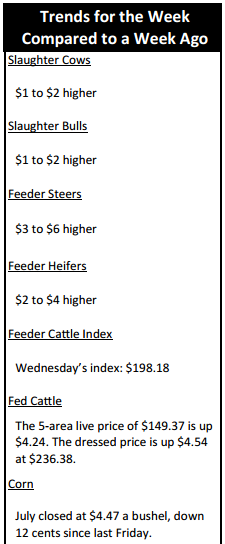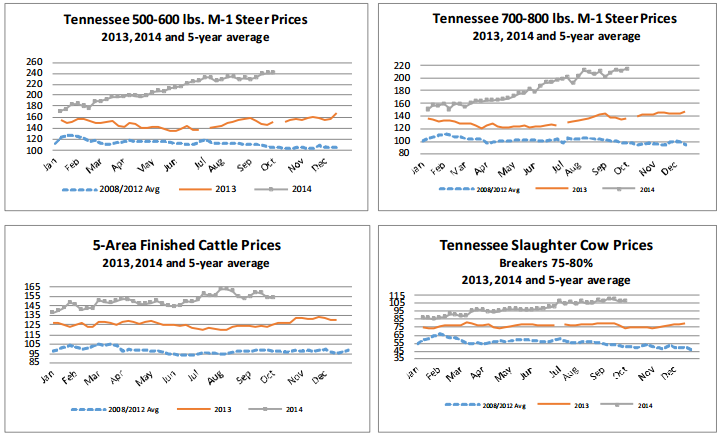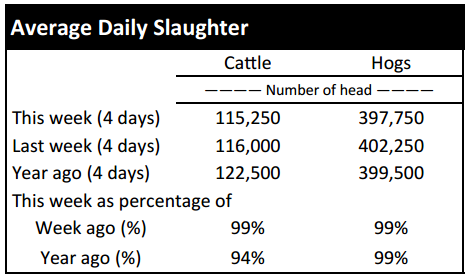Market Highlights: High Prices Continue

All areas of the beef industry continue to see higher price gains.
By: Andrew P. Griffith, University of Tennessee
FED CATTLE: Fed cattle traded $2 to $3 higher on a live basis compared to last week. Prices on a live basis were mainly $148 to $150 while dressed trade occurred between $236 and $238. The 5-area weighted average prices thru Thursday were $149.37 live, up $4.24 from last week and $236.38 dressed, up $4.54 from a week ago.
A year ago prices were $124.21 live and $194.50 dressed. The question may be if summer lows have already been experienced in the fed cattle market. Seasonally speaking, fed cattle prices decline into the summer following the spring high before wind catches the market’s sails again in the latter part of summer and heading into the fall high.
Looking at the historical price decline moving from spring highs to summer lows, fed cattle prices could have been expected to dip to the mid to upper $130 region. However, market prices have continued to sizzle through the middle of June, and it appears the summer lows may have already been set. There is still time for the fed cattle market to break, but such a break is becoming less likely with each passing day and ever higher feeder cattle prices.
BEEF CUTOUT: At midday Friday, the Choice cutout was $231.53 up $0.64 from Thursday and up $1.59 from last Friday. The Select cutout was $223.89 up $0.29 from Thursday and up $2.73 from last Friday. The Choice Select spread was $7.64 compared to $8.78 a week ago.
Wholesale beef prices are struggling to keep pace with the fed cattle market, but they continue to trudge forward. World meat protein demand continues to strengthen which provides support for domestic beef, but many in the industry continue to question consumer push back.
Consumers have always provided resistance to higher prices in beef, and they will continue to do so. The resistance is evident by a reduction in the quantity of beef demanded while demand itself has remained relatively strong. When prices escalate consumers tend to reduce the quantity purchased, but that does not mean demand for the good has declined. It just means the quantity of beef demanded has reacted to a price change. Thus, consumers will continue to resist higher prices while beef packers will continue to push higher prices in hopes of maintaining positive margins. Those margins however have been on the thinning order as fed cattle prices have escalated more quickly than the beef cutout. Choice beef may struggle through the heat of summer, before finding late summer support.
TENNESSEE AUCTIONS: On Tennessee auctions this week compared to a week ago steers and bulls were $3 to $6 higher. Heifers were $2 to $4 higher. Slaughter cows and bulls were $1 to $2 higher. Average receipts per sale were 689 head on 12 sales compared to 917 head on 10 sales last week and 764 head on 10 sales last year.
OUTLOOK: Feeder cattle futures on nearby and deferred contracts continue setting record highs and pacing the local cash market to new highs. Record prices are pulling calves out of pastures left and right and they have producers setting wheels under a number of calves that would generally be marketed later in the year. The act of pulling calves forward and shipping them to town has increased the number of lightweight calves going through the market.
The immediate implication is that local auction markets continue to have strong numbers crossing the scales and there are a number of extremely lightweight calves available for stocker producers to place on pasture or feed. The longer term implication is that many auction market operators will likely be sitting on their hands this fall when many of these calves would traditionally come to market because cattle receipts are likely to be extremely low relative to previous years. Additionally, producers who normally purchase stocker calves in the fall to graze winter annuals or stockpiled forage will be looking at a thin selection of calves relative to previous years.
Many cow-calf producers are leaving money on the table by pulling these calves forward. The weekly auction market average price for 427 pound steers was $238.81 per hundredweight which is $1,020 per head while 527 pound steers averaged $223.95 per hundredweight for a total per head value of $1,180. The additional hundred pounds was worth $160 which is a value of gain of $1.60 per pound. Similarly, carrying calves from 427 pounds to 623 pounds had a value of gain of $1.37 per pound. Thus, given the prices received for heavier calves, a number of producers are passing considerable value on to the buyer. 
TECHNICALLY SPEAKING: Based on Thursday’s closing prices, June closed at $146.00. Support is at $144.08 then $141.18. Resistance is at $146.98, then $149.88. The RSI is 76.09. August closed at $145.05. Support is at $143.23, then $140.43. Resistance is at $146.03, then $148.83. The RSI is 72.06. October closed at $148.05. Support is at $145.80, then $145.48. Resistance is at $148.25, then $148.26. The RSI is 72.21. August feeders closed at $205.85. Support is at $204.06, then $201.36. Resistance is at $206.76, then $209.46. The RSI is 77.12. November feeders closed at $206.48. Support is at $206.30, then $203.78. Resistance is at $206.50 then $206.51. The RSI is 80.53. January feeders closed at $201.33. Support is at $200.10, then $199.25. Resistance is at $201.35 then $201.36. The RSI is 83.45. Friday’s closing prices were as follows: Live/fed cattle – June $147.60 +1.60; August $146.63 +1.58; October $149.85 +1.80; Feeder cattle - August $208.15 +2.30; October $208.80 +2.20; November $208.15 +1.68; January $203.33 +2.00; July corn closed at $4.47 up $0.03 from Thursday.










